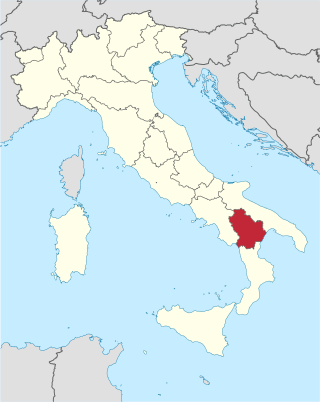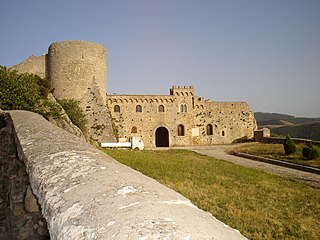
Matera is a city and the capital of the Province of Matera in the region of Basilicata, in Southern Italy. With a history of continuous occupation dating back to the Palaeolithic, it is renowned for its rock-cut urban core, whose twin cliffside zones are known collectively as the Sassi.

Basilicata, also known by its ancient name Lucania, is an administrative region in Southern Italy, bordering on Campania to the west, Apulia to the north and east, and Calabria to the south. It has two coastlines: a 30-km stretch on the Tyrrhenian Sea between Campania and Calabria, and a longer coastline along the Gulf of Taranto between Calabria and Apulia. The region can be thought of as the "instep" of the "boot" of Italy, with Calabria functioning as the "toe" and Apulia the "heel".

A maypole is a tall wooden pole erected as a part of various European folk festivals, around which a maypole dance often takes place.

Magasa is a town and comune in the province of Brescia, in Lombardy in northern Italy.

Guardia Sanframondi is a town and comune in the Province of Benevento, in Campania region, in Italy. It is best known for its wine production, the wine festival Vinalia and for its Christian penitential rite held every seven years.

Accettura is a town and comune in the province of Matera, in the Southern Italian region of Basilicata. It is bounded by the comuni of Calciano, Campomaggiore, Cirigliano, Oliveto Lucano, Pietrapertosa, San Mauro Forte and Stigliano.

Acerenza is a town and comune in the province of Potenza, in the Southern Italian region of Basilicata. It is one of I Borghi più belli d'Italia.
Saint Gabinus is the title given to two personages.

San Vito dei Normanni is an Italian town of 19,947 inhabitants of the province of Brindisi in Apulia. The inhabitants are called Sanvitesi and the town is sometimes referred to as San Vito.

Venafro is a comune in the province of Isernia, region of Molise, Italy. It has a population of 11,079, having expanded quickly in the post-war period.

Santa Cristina Gela is an Arbëreshë village in the Metropolitan City of Palermo in Sicily.

Irsina, until 1895 called Montepeloso, is a town, comune (municipality) and former Latin bishopric in the province of Matera, in the Southern Italian region of Basilicata. It is one of I Borghi più belli d'Italia.

Oliveto Lucano is a town and comune in the province of Matera, in the Southern Italian region of Basilicata. Its mayor is Nicola Terranova. This town is most known for the "Maggio Festival", which is dedicated to St. Cyprian and takes place on 10, 11 and 12 August.
Stigliano is a town and comune in the province of Matera, in the Basilicata region of southern Italy.

Bovino is a comune and hill town at the eastern side of the Apennines in the province of Foggia, Apulia, southern Italy.
Cesa is a comune (municipality) in the Province of Caserta in the Italian region Campania, located about 15 kilometres (9 mi) north of Naples and about 14 kilometres (9 mi) southwest of Caserta.

Colletorto is a comune (municipality) of approximately 1,786 inhabitants in the province of Campobasso, in the Italian region of Molise, located about 45 kilometres (28 mi) from the capital of the region Campobasso and 40 kilometres (25 mi) from Termoli (CB), sea town with port, railway and highway A14.

San Vincenzo Martire di Craco is a minor saint of the Roman Catholic Church. He is remembered in devotions by the people of Craco in the province of Matera, the Basilicata Region, Italy along with immigrants and their descendants from that town who settled in North America. San Vincenzo Martire di Craco's feast day is celebrated on the fourth Sunday of October in Craco, Italy and Manhattan, New York.
The Serbs have many traditions. The Slava is an exclusive custom of the Serbs, each family has one patron saint that they venerate on their feast day. The Serbian Orthodox Church uses the traditional Julian Calendar, as per which Christmas Day falls currently on January 7 of the Gregorian Calendar, thus the Serbs celebrate Christmas on January 7, shared with the Orthodox churches of Jerusalem, Russia, Georgia, Ukraine and the Greek Old Calendarists.

Traditions of Italy are sets of traditions, beliefs, values, and customs that belongs within the culture of Italian people. These traditions have influenced life in Italy for centuries, and are still practiced in modern times. Italian traditions are directly connected to Italy's ancestors, which says even more about Italian history.



















